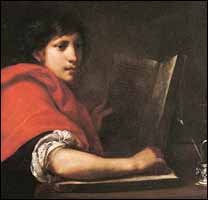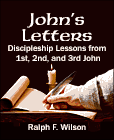Free E-Mail
Bible Studies
Beginning the Journey (for new Christians). en Español
Old Testament
Abraham
Jacob
Moses
Joshua
Gideon
David, Life of
Elijah
Psalms
Solomon
Songs of Ascent (Ps 120-135)
Isaiah
Advent/Messianic Scriptures
Daniel
Rebuild & Renew: Post-Exilic Books
Gospels
Christmas Incarnation
(Mt, Lk)
Sermon on the Mount
(Mt 5-7)
Mark
Luke's
Gospel
John's Gospel
7 Last Words of Christ
Parables
Jesus and the Kingdom
Resurrection
Apostle Peter
Acts
The Early Church
(Acts 1-12)
Apostle Paul
(Acts 12-28)
Paul's Epistles
Christ Powered Life (Rom 5-8)
1 Corinthians
2 Corinthians
Galatians
Ephesians
Vision for Church
(Eph)
Philippians
Colossians,
Philemon
1
& 2 Thessalonians
1 & 2 Timothy,
Titus
General Epistles
Hebrews
James
1 Peter
2 Peter, Jude
1, 2, and 3 John
Revelation
Revelation
Conquering Lamb of Revelation
Topical
Glorious Kingdom, The
Grace
Great Prayers
Holy Spirit, Disciple's Guide
Humility
Lamb of God
Listening for God's Voice
Lord's Supper
Names of God
Names of Jesus
Christian Art
About Us
Podcasts
Contact Us
Dr. Wilson's Books
Donations
Watercolors
Sitemap
 Detail from Francesco Furini, "St. John the Evangelist" (1630s), oil on canvas. Musée des Beaux-Arts, Lyon. Full image. |
Authorship
The first question we'll tackle is who wrote these letters? The First Letter of John is anonymous. Second and Third John are written by an author who identifies himself as "the Elder."
External Evidence for John the Apostle as the author of these letters is quite strong. While there may be allusions to 1 John in 1 Clement and the Didache, the earliest clear reference comes from Polycarp of Smyrna (died c. 155 AD) who quoted directly from 1 John 4:2-3 and 2:24 (written perhaps 115 AD), though without reference to the author.
But there are specific references to the Apostle John's authorship by Papias of Hierapolis (mid-second century),1 Irenaeus (lived about 130-200 AD),2 Clement of Alexandria (c. 150-215 AD),3 Tertullian (died about 220 AD),4 and Origen of Alexandria (died about 255 AD).5 In the Muratorian Canon (Rome, between 170 and 215 AD) letters are attributed to John, while by the time of Eusebius (about 325 AD), First John is listed among the "acknowledged books," while Second and Third John are listed among the "disputed books," but as "well-known and acknowledged by most."6
Internal Evidence for John the Apostle as the author of these letters is also strong. While I must refer you to the commentaries, which cover the arguments in detail, I believe that a very good case can be made that:
- A common author penned these letters.
- The same author wrote the Gospel of John.
- The author claims to be an eyewitness of the events of Jesus'life.
- The author writes with a self-conscious authority as might an apostle.
While 1 John is anonymous and not in letter format, it is clear that this is not just a theological treatise penned for a general audience, but is very personal. The author knows his readers, for he refers to them as "dear children" or "little children," as well as "beloved" or "dear friends."
I believe it is rather clear: These letters are written by the Apostle John.
The Ministry of the Apostle John
We first get to know John the Apostle when he was called with his brother James, both of whom Jesus nicknamed the "Sons of Thunder" (Mark 3:17). Their father was Zebedee. Their mother was probably Salome, who may have been Jesus'mother's sister (Matthew 27:56 with Mark 15:40; John 19:25). Thus John may have been Jesus'cousin. He and his brother James were fisherman on the Sea of Galilee, working with their father. He was an "unschooled, ordinary" man (Acts 4:13). When Jesus called them, they followed immediately (Mark 1:19-20).
During Jesus'ministry, John isn't usually mentioned alone by name, but usually along with his brother James or with Peter. He was one of Jesus'inner circle -- Peter, James, and John -- and thus was present at the transfiguration, at the raising of Jairus'daughter, and in the Garden of Gethsemane.
Early in his discipleship, John seems to have struggled with pride, for Jesus rebukes him and his brother for seeking to sit on his right and left in the Kingdom (Mark 10:35-40), for trying to stop a man who is casting out demons in Jesus'name (Luke 9:49-50), and for wanting to call down fire upon a Samaritan village that didn't welcome Jesus (Luke 9:51-56). John's brother James was the first martyr among the apostles (Acts 12:2).
If John the Apostle is the author of the Gospel of John (as I believe he is), then he is "the disciple whom Jesus loved," a disciple particularly close to Jesus. He leaned on Jesus'breast at the Last Supper (John 13:23), was appointed to care for Jesus'mother at the cross (John 19:26-27), and recognized Jesus in the miraculous catch of fish (John 21:7). He may also have been the "other disciple" who knew the high priest (John 18:15-16) and also the one who ran with Peter to the empty tomb (John 20:3-9).
In the life of the early church he is associated with Peter in healing the lame man at the temple (Acts 3:1-10), and appearing before the Sanhedrin for their bold teaching about Jesus and the resurrection (Acts 4:1-31). He was arrested, released by an angel, and later flogged with the other apostles (Acts 5:18-41). In Galatians 2:9 he is mentioned as a "pillar" of the Jerusalem church. But that's the last Bible reference to him.
However, early church history is pretty much agreed that John the Apostle lived and ministered in Asia Minor toward the end of his life. He was exiled to the island of Patmos (Revelation 1:9) during the persecution of Domitian (reigned 81 to 96 AD), specifically in Domitian's fourteenth year,7 that is, about 95 AD. Eusebius records a strong persecution by Domitian against Christians. Domitian was assassinated on September 18, 96 AD.8 St. Jerome (c. 347-420) writes that after this:
"[John] returned to Ephesus under [Emperor] Pertinax and continuing there until the time of the Emperor Trajan [reigned 98-117 AD], founded and built churches throughout all Asia, and, worn out by old age, died in the sixty-eighth year after our Lord's passion and was buried near the same city."9
Eusebius (c. 263 - c. 339 AD), citing the writings of Irenaeus and Clement of Alexandria, says:
"At that time, the apostle and evangelist John, the one whom Jesus loved, was still living in Asia, and governing the churches of that region, having returned after the death of Domitian from his exile on the island."10
This would put his death after 98 AD. His tomb is thought to be located at Selçuk, a small town about two miles northeast of Ephesus. He was apparently the only disciple of the original twelve who died of natural causes, as alluded to at the end of John's Gospel (21:23-23).
Stories from the Early Fathers that illustrate his character can be found in an Appendix.
Provenance and Date
To whom was First John written? As we'll see in the letters themselves, John's recipients are probably not Palestinian Jews, but either converted Diaspora Jews living in Ephesus, and, more likely, gentiles who had been converted from the polytheism that was rampant in Asia Minor.
 The study is available as a free e-mail Bible study, or as an e-book or paperback book at a modest cost. |
Some have sought to organize this in some way or another. Marshall summarizes various attempts to outline John's thought and observes that no approach is free from difficulties. He concludes:
"It seems preferable to regard the Epistle as being composed of a series of connected paragraphs whose relation to one another is governed by association of ideas rather than by a logical plan. This does not mean that John is illogical, but rather that his Epistle is not meant to be divided into large sections on a logical basis."21
We've looked at some of the issues behind the writing of John's Letters. Now let's begin to study them in detail to learn hat God will say to us through this old apostle of our Lord.
1 Eusebius, Church History, 3, 39, 17.
2 Irenaeus (Against Heresies, 3, 16, 18) identifies John as both the "disciple of the Lord" and the author of the Fourth Gospel. And he quotes from both First and Second John.
3 Clement of Alexandria is aware of more than one letter, since he refers to "the greater Epistle" and ascribes it to "the apostle John." He quotes first John extensively in Stromateis 2-5 and Quis Dives Salvetur? 37-38.
4 Tertullian quotes from First John about fifty times.
5 Origen also ascribes the First Epistle to John.
6 Eusebius, Church History, 3, 25, 2-3.
7 Jerome, De viris illustribus (On Illustrious Men), 9.
8 Eusebius, Church History III, 18-20.
10 Eusebius, Church History, III, 23, 1-4.
11 Gary M. Bunge, "John, Letters of," DLNT, p. 595.
12 David M. Scholer, “Gnosis, Gnosticism,” DLNT, pp. 400-412.
13 Bunge, p. 591.
14 David F. Wright, “Docetism,” DLNT, pp. 306-309.
15 Bunge, p. 591. See also Philip Schaff, “Cerinthus,” History of the Christian Church, vol. 2, chapter 11, §123. Irenaeus, Against Heresies, I, 11, 1; I, 26, 1. Brown (Epistles of John, pp. 65-68 and Appendix II, pp. 766-771) argues that Cerinthus was not a contemporary of John after all, but later. I'm not convinced.
16 John 1:1; 1 John 1:1.
17 Irenaeus, Against Heresies, III, 3, 4 (translated by Alexander Roberts and William Rambaut from Ante-Nicene Fathers (Christian Literature Publishing Co., 1885), vol. 1.
18 Stott, John, p. 47. Irenaeus (Against Heresies 3.11.1) asserts that John wrote his Gospel to oppose the errors propogated by Cerinthus.
19 Stott, John, pp. 41-42.
20 Eusebius, Church History, III, 28.
21 Marshall, John, pp. 22-26.
Copyright © 2025, Ralph F. Wilson. <pastor![]() joyfulheart.com> All rights reserved. A single copy of this article is free. Do not put this on a website. See legal, copyright, and reprint information.
joyfulheart.com> All rights reserved. A single copy of this article is free. Do not put this on a website. See legal, copyright, and reprint information.
 |

|
In-depth Bible study books
You can purchase one of Dr. Wilson's complete Bible studies in PDF, Kindle, or paperback format -- currently 48 books in the JesusWalk Bible Study Series.
Old Testament
- Abraham, Faith of
- Jacob, Life of
- Moses the Reluctant Leader
- Joshua
- Gideon
- David, Life of
- Elijah
- Psalms
- Solomon
- Songs of Ascent (Psalms 120-134)
- Isaiah
- 28 Advent Scriptures (Messianic)
- Daniel
- Rebuild & Renew: Post-Exilic Books
Gospels
- Christmas Incarnation (Mt, Lk)
- Sermon on the Mount (Mt 5-7)
- Luke's Gospel
- John's Gospel
- Seven Last Words of Christ
- Parables
- Jesus and the Kingdom of God
- Resurrection and Easter Faith
- Apostle Peter
Acts
Pauline Epistles
- Romans 5-8 (Christ-Powered Life)
- 1 Corinthians
- 2 Corinthians
- Galatians
- Ephesians
- Philippians
- Colossians, Philemon
- 1 & 2 Thessalonians
- 1 &2 Timothy, Titus
General Epistles
Revelation
Topical


 To be notified about future articles, stories, and Bible studies, why don't you subscribe to our free newsletter, The Joyful Heart, by placing your e-mail address in the box below. We respect your
To be notified about future articles, stories, and Bible studies, why don't you subscribe to our free newsletter, The Joyful Heart, by placing your e-mail address in the box below. We respect your